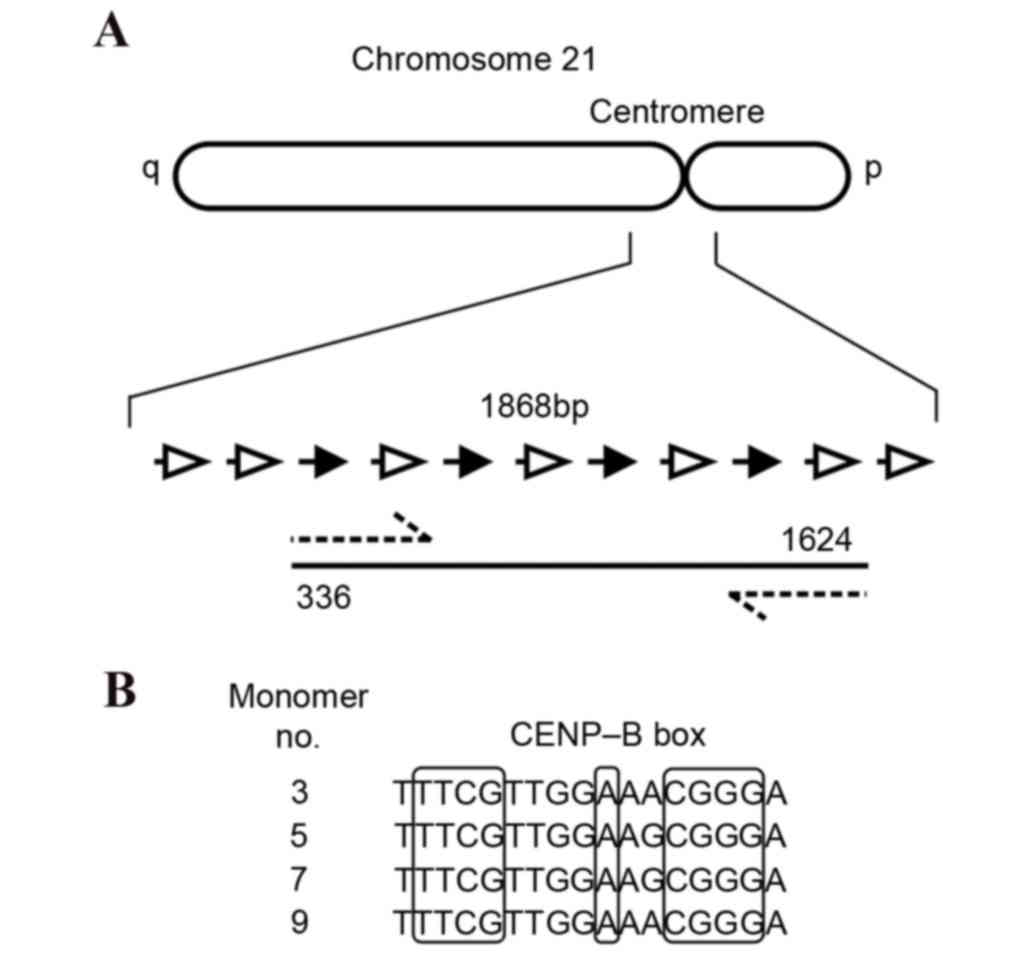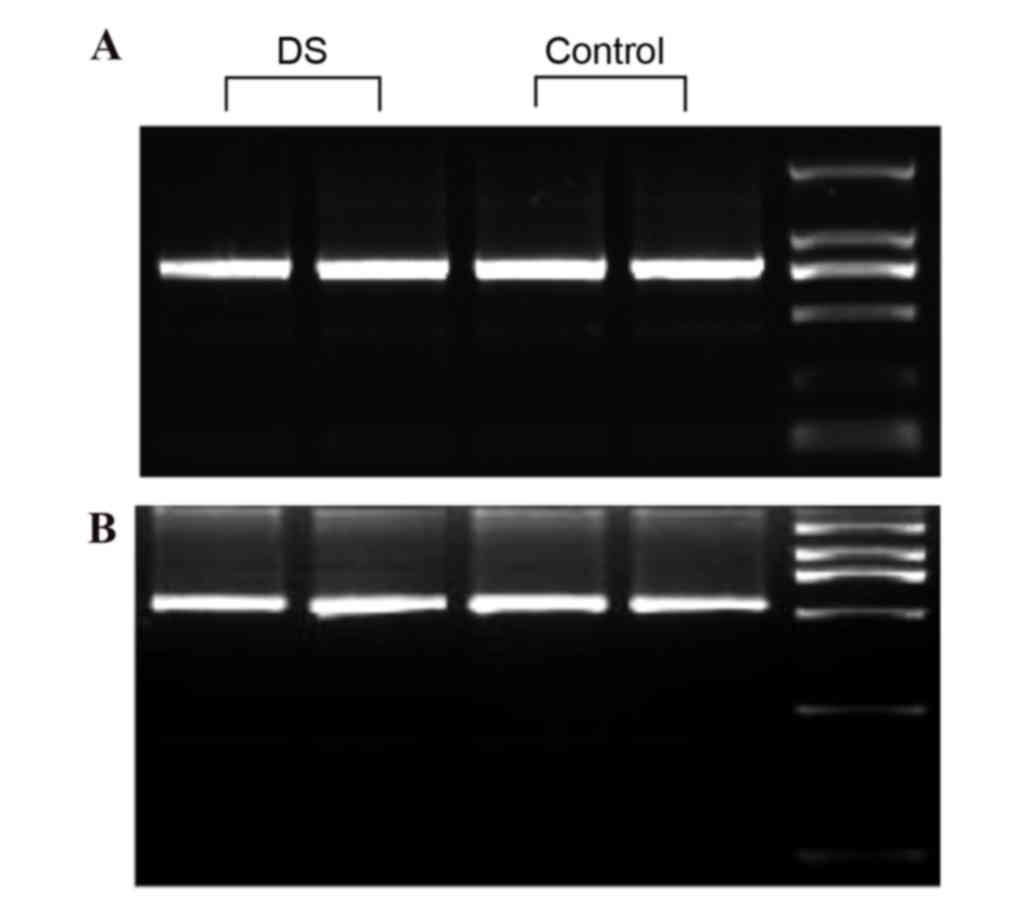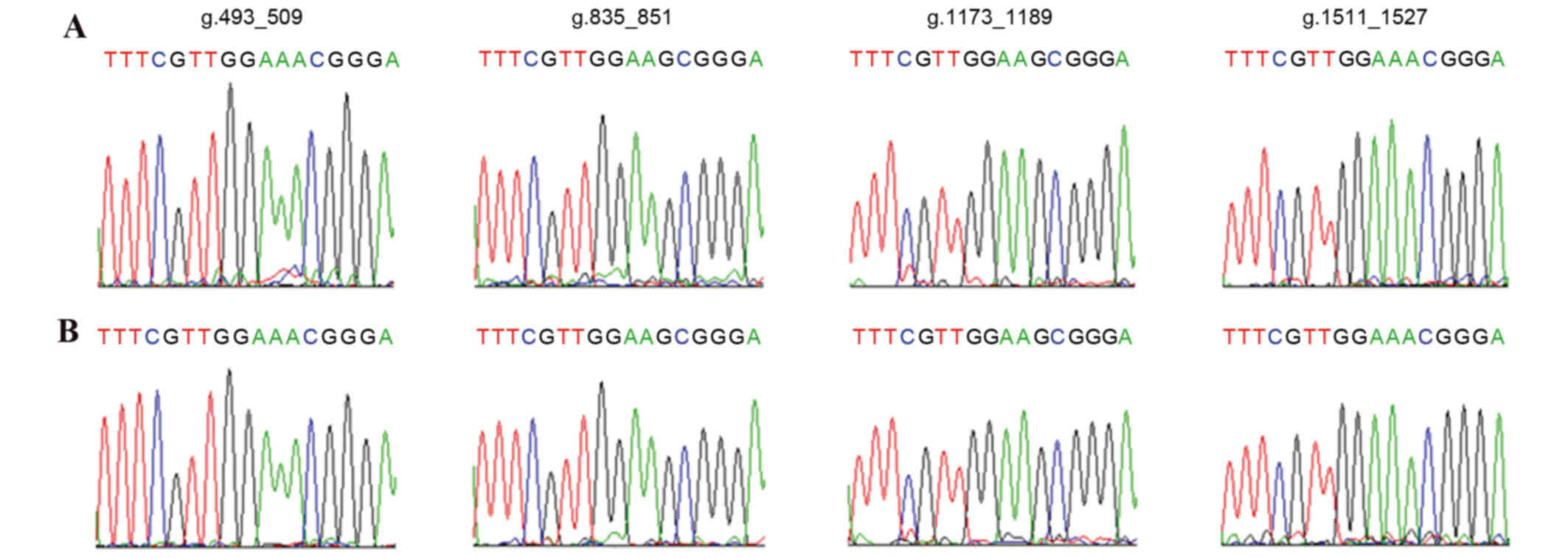Mutational spectrum of CENP-B box and α-satellite DNA on chromosome 21 in Down syndrome children
- Authors:
- Published online on: February 24, 2017 https://doi.org/10.3892/mmr.2017.6247
- Pages: 2313-2317
Abstract
Introduction
Down syndrome (DS), or trisomy 21, results from the presence of all or part of an extra chromosome (Chr) 21 and is a high-incidence birth defect that is often associated with physical disorders (1–3) that have no explicit mechanism. Incorrect partitioning of sister chromatids to the daughter cells may induce aneuploidy, including trisomy 21 (4,5). Centromeres, the evident structures that are located in the center of chromosomes are responsible for chromosome segregation. A previous study indicated that the highly conserved centromere protein B (CENP-B) and its 17 base pair (bp) binding site (CENP-B box) are required for de novo mammalian artificial chromosome formation (6). In vivo analyses with cultured human cells suggested that the presence of the CENP-B box is essential for the formation of functional centromere components (7,8). In addition, CENP-B binding to the CENP-B boxes influences nucleosome positioning in centromeric regions and this binding is required for accurate chromosome segregation (9–11). Therefore, this suggests that nondisjunction of Chr21 may be induced by a defective functioning of the centromere with a CENP-B box mutation.
To determine whether the mutation or absence of the CENP-B box is involved with extra Chr21 formation in DS, the CENP-B boxes in Chr21 α-satellite DNA (α-satDNA) of 127 DS children were investigated using polymerase chain reaction (PCR) and direct sequencing. The observations of the present study provide an insight into the molecular association between the CENP-B box and α-satDNA in Chr21, which may be a major contributor to the occurrence of trisomy 21.
Materials and methods
Patient recruitment
A total of 127 Chinese children with DS were recruited from the Children's Hospital of Chongqing Medical University (Chongqing, China). Cytogenetic analysis demonstrated the karyotypes were 47, XY, +21 or 47, XX, +21 in all the patients. In addition, 100 healthy children with normal karyotypes were also enrolled as the control group. The distribution of age and residential placement did not differ between controls and DS patients. Peripheral blood samples were collected from all participants. The study was approved by the Ethics Committee of Chongqing Medical University. Informed consent was obtained from all individual participants included in the study.
PCR amplification and sequencing
Genomic DNA was extracted from peripheral blood samples with TIANamp Blood DNA kit (Tiangen Biotech Co., Ltd., Beijing, China). α-satDNA (GenBank accession no. D29750.1) in the centromeric region of Chr21 was amplified as two overlapping fragments, with each fragment containing two CENP-B boxes (Fig. 1). Oligonucleotide primer sequences were as follows: α-satellite part A, forward 5′-GGAATATCGTCATACAAAAT-3′, reverse 5′-TATCAATGGCAAAGTTCA-3′; and α-satellite part B, forward 5′-GTTGAACTTTGCCATTGA-3′, and reverse, 5′-GCTCTAAGAAAGCGAATG-3′. PCR was performed using the Takara Taq™ PCR kit (Takara Biotechnology, Co., Ltd., Dalian, China), according to the manufacturer's protocol, using 200 ng genomic DNA and 20 nM primers (1 µl). PCR thermocycling conditions were as follows: 94°C for 4 min (initial denaturation), followed by 30 cycles at 95°C for 30 sec (denaturation), 46°C/43°C for 30 sec (primer annealing) for part A/B, respectively, and 72°C for 45 sec (PCR product elongation), a final extension step was at 72°C for 5 min. PCR products were run on 1.5% agarose gels to detect possible large sequence rearrangements. Following the removal of unincorporated primers and excess dNTPs by exonuclease I and shrimp alkaline phosphatase, the amplified fragments were directly sequenced on an ABI-3100 Genetic Analyzer (Applied Biosystems; Thermo Fisher Scientific, Inc., Waltham, MA, USA). Each sample was compared with NCBI RefSeq sequence of α-satDNA.
Statistical analysis
Statistical analysis was used to summarize the clinical characteristics of the subjects. Associations between polymorphisms of DS and control group were examined using the Chi-square test. P<0.05 was considered to indicate a statistically significant difference. All data were analyzed using SPSS software, version 16.0 (SPSS, Inc., Chicago, IL, USA).
Results
Gel electrophoresis
The gel electrophoresis indicated that the 773 and 535 bp PCR fragments from α-satDNA were amplified correctly. There was no observation of a mispairing present in the agarose gels. There was no visible difference in gel electrophoresis between amplified fragments of DS and healthy children (Fig. 2). To examine whether the two fragments exhibited a point mutation, direct sequencing was performed following gel electrophoresis.
CENP-B boxes in Chr21 are highly conserved
The affected patients with DS and healthy children underwent DNA analysis by sequencing of PCR products, of four CENP-B boxes that are respectively located at the g.493_509, g.835_851, g.1173_1189 and g.1511_1527 sites of α-satDNA in Chr21. No mutation or absence of CENP-B boxes in the 127 patients with DS and 100 healthy children was observed. All four CENP-B boxes in Chr21 were demonstrated to be highly conserved (Fig. 3).
α-satDNA sequence is highly variable
The direct sequencing of α-satDNA indicated numerous underlying nucleotide alterations. The variations were point nucleotide deletions, substitutions, insertions and polymorphisms. The novel identified mutations were as follows: g.661delC, g.670T>G, g.1239A>T, g.1343T>C, g.1035_1036insA and g.1076_1077insC (Fig. 4). All the mutations were observed to be present in DS and control groups, however statistical analysis suggested that there was no significant difference between their occurrence in the two groups (P>0.05; Table I). Furthermore, 8 polymorphism sites were observed in the majority of samples and to the best of our knowledge, these had not previously been reported. However, occurrence of the g.525C/G (P=0.01), g.601T/C (P=0.00000002), g.1279A/G (P=0.002), g.1294C/T (P=0.0006) and g.1302 G/T (P=0.004) sites in the DS group demonstrated a significant difference compared with the control group (P<0.05) However, no differences in g.727C/T (P=0.36), g.863A/C (P=0.207) and g.1264C/G (P=0.073) sites were observed between the two groups (Fig. 5; Table I).
Discussion
DS is a common chromosomal disorder in human aneuploidy, and a termination of pregnancy occurs for the majority DS fetuses identified via Down's screening and amniocentesis. The extra Chr21 results from a meiotic nondisjunction event, with 88% from nondisjunction in the maternal gamete and 8% in the paternal gamete. But the underlying molecular genetics mechanism linking nondisjunction to Chr21 remains to be fully elucidated. Therefore, it is necessary to determine the genotypes of DS to provide a methodology for antenatal examination and gene diagnosis for trisomy 21 in noninvasive prenatal testing.
The current study identified that the CENP-B boxes are highly conserved in DS and healthy children. Human Chr21 contains a large repetitive sequence and consists of 11 tandem repeats of an AT-rich 171 bp alphoid monomer unit. This 11mer repeat construct is a 1.3 Mbp higher order α-satDNA repeat on the centromeric area. Each monomer has a unique 17 bp sequence, however only five have the CENP-B binding activity known as the CENP-B box (12,13). In the human artificial chromosome (HAC), CENP-B box mutations induced no HAC formation and diminution of CENP-A assembly (6,11,14). CpG methylation and point mutation of the CENP-B box reduced CENP-B binding activity (15–17). Therefore, the CENP-B box is required for de novo centromere chromatin assembly on human α-satDNA. The present study identified the methylation status of CpG dinucleotides in CG islands; however, the results did not show any difference in the DNA methylation status between DS and healthy people as previously described (18).
A cohort of 127 patients diagnosed with DS and 100 healthy children in Chongqing were investigated via chromosome screening. The spectrum of α-satDNA variants in Chr21 was analyzed by direct DNA sequencing. The present study identified 14 novel variations that, to the best of our knowledge, have not previously been reported. A total of 6 mutations were identified in the Chinese population: g.661delC, g.670T>G, g.1239A>T, g.1343T>C, g.1035_1036insA and g.1076_1077insC. The present study revealed the distribution and frequency of novel variations among the population in Chongqing. For human Chr21, α-satDNA appears to be the major constituent of functional centromeres (19), as it is associated with the existence of functional centromere components on the endogenous human chromosome and the ability to induce de novo centromere assembly. In the present study, the CENP-B box and α-satDNA sequence were required for de novo mammalian artificial chromosome formation and assembly of functional centromere components, including CENP-A, CENP-C, and CENP-E (20,21). These results demonstrated the presence of a variable in α-satDNA, other than the CENP-B box, which may be important for de novo centromere formation function (8,16,22,23). In addition, the present study reported eight single nucleotide polymorphisms (SNPs) of α-satDNA in Chr21. Three SNPs, including g.727C/T, g.863A/C and g.1264C/G did not demonstrate any difference in occurrence between DS and healthy children. It was therefore hypothesized that the variants identified in the present study may be due to ethnic disparities, as suggested by previous studies (18,24) and consequently, these variants may act as DNA markers for distinguishing ethnicities. However, five SNPs including g.525C/G, g.601T/C, g.1279A/G, g.1294C/T and g.1302 G/T were observed to be significantly different between the DS and control group, and may therefore act as potential molecular diagnostic markers of DS.
The present study exhibited various limitations. Firstly, the study was conducted on a small sample size and larger sample sizes are required to confirm these associations in the future. Furthermore, the patients were from the same region of China, therefore further studies should include individuals from different regions of China and of different ethnicities.
In conclusion, the present study investigated the α-satDNA variants present in Chr21 and any differences in genotype between DS and healthy children. The results demonstrated that CENP-B box mutations were not present and the box appears to be highly conserved in DS patients and therefore may not be responsible for Chr21 nondisjunction events. Furthermore, 14 novel variations were identified in this investigation and the differing mutation spectrum of α-satDNA between DS and healthy individuals may contribute to complex DS phenotypes and act as potential dinucleotide markers for diagnosing trisomy 21.
Acknowledgements
The authors would like to thank Dr Lin Zou and Dr Cui Song (Center of Clinical Molecular Medicine, Children's Hospital of Chongqing Medical University; Chongqing, China) for case collection. The present study was supported by the National Natural Science Foundation of China (grant no. 30771202).
Glossary
Abbreviations
Abbreviations:
|
α-satDNA |
α-satellite DNA |
|
CENP-B |
centromere protein B |
|
Chr21 |
chromosome 21 |
|
DS |
Down syndrome |
|
HAC |
human artificial chromosome |
|
PCR |
polymerase chain reaction |
References
|
Shott SR, Joseph A and Heithaus D: Hearing loss in children with Down syndrome. Int J Pediatr Otorhinolaryngol. 61:199–205. 2001. View Article : Google Scholar : PubMed/NCBI | |
|
Nespoli L, Burgio GR, Ugazio AG and Maccario R: Immunological features of Down's syndrome: A review. J Intellect Disabil Res. 37:543–551. 1993. View Article : Google Scholar : PubMed/NCBI | |
|
Karlsson B, Gustafsson J, Hedov G, Ivarsson SA and Annerén G: Thyroid dysfunction in Down's syndrome: Relation to age and thyroid autoimmunity. Arch Dis Child. 79:242–245. 1998. View Article : Google Scholar : PubMed/NCBI | |
|
Wittmann T, Hyman A and Desai A: The spindle: A dynamic assembly of microtubules and motors. Nat Cell Biol. 3:E28–E34. 2001. View Article : Google Scholar : PubMed/NCBI | |
|
Walczak CE and Heald R: Mechanisms of mitotic spindle assembly and function. Int Rev Cytol. 265:111–158. 2008. View Article : Google Scholar : PubMed/NCBI | |
|
Ohzeki J, Nakano M, Okada T and Masumoto H: CENP-B box is required for de novo centromere chromatin assembly on human alphoid DNA. J Cell Biol. 159:765–775. 2002. View Article : Google Scholar : PubMed/NCBI | |
|
Trowell HE, Nagy A, Vissel B and Choo KH: Long-range analyses of the centromeric regions of human chromosomes 13, 14 and 21: Identification of a narrow domain containing two key centromeric DNA elements. Hum Mol Genet. 2:1639–1649. 1993. View Article : Google Scholar : PubMed/NCBI | |
|
Okada T, Ohzeki J, Nakano M, Yoda K, Brinkley WR, Larionov V and Masumoto H: CENP-B controls centromere formation depending on the chromatin context. Cell. 131:1287–1300. 2007. View Article : Google Scholar : PubMed/NCBI | |
|
Tanaka Y, Tachiwana H, Yoda K, Masumoto H, Okazaki T, Kurumizaka H and Yokoyama S: Human centromere protein B induces translational positioning of nucleosomes on alpha-satellite sequences. J Biol Chem. 280:41609–41618. 2005. View Article : Google Scholar : PubMed/NCBI | |
|
Hasson D, Panchenko T, Salimian KJ, Salman MU, Sekulic N, Alonso A, Warburton PE and Black BE: The octamer is the major form of CENP-A nucleosomes at human centromeres. Nat Struct Mol Biol. 20:687–695. 2013. View Article : Google Scholar : PubMed/NCBI | |
|
Okamoto Y, Nakano M, Ohzeki J, Larionov V and Masumoto H: A minimal CENP-A core is required for nucleation and maintenance of a functional human centromere. EMBO J. 26:1279–1291. 2007. View Article : Google Scholar : PubMed/NCBI | |
|
Ikeno M, Masumoto H and Okazaki T: Distribution of CENP-B boxes reflected in CREST centromere antigenic sites on long-range alpha-satellite DNA arrays of human chromosome 21. Hum Mol Genet. 3:1245–1257. 1994. View Article : Google Scholar : PubMed/NCBI | |
|
Alkan C, Ventura M, Archidiacono N, Rocchi M, Sahinalp SC and Eichler EE: Organization and evolution of primate centromeric DNA from whole-genome shotgun sequence data. PLoS Comput Biol. 3:1807–1820. 2007. View Article : Google Scholar : PubMed/NCBI | |
|
Basu J, Stromberg G, Compitello G, Willard HF and Van Bokkelen G: Rapid creation of BAC-based human artificial chromosome vectors by transposition with synthetic alpha-satellite arrays. Nucleic Acids Res. 33:587–596. 2005. View Article : Google Scholar : PubMed/NCBI | |
|
Earnshaw WC, Sullivan KF, Machlin PS, Cooke CA, Kaiser DA, Pollard TD, Rothfield NF and Cleveland DW: Molecular cloning of cDNA for CENP-B, the major human centromere autoantigen. J Cell Biol. 104:817–829. 1987. View Article : Google Scholar : PubMed/NCBI | |
|
Masumoto H, Masukata H, Muro Y, Nozaki N and Okazaki T: A human centromere antigen (CENP-B) interacts with a short specific sequence in alphoid DNA, a human centromeric satellite. J Cell Biol. 109:1963–1973. 1989. View Article : Google Scholar : PubMed/NCBI | |
|
Tanaka Y, Kurumizaka H and Yokoyama S: CpG methylation of the CENP-B box reduces human CENP-B binding. FEBS J. 272:282–289. 2005. View Article : Google Scholar : PubMed/NCBI | |
|
Xia YY, Ding YB, Liu XQ, Chen XM, Cheng SQ, Li LB, Ma MF, He JL and Wang YX: Allelic methylation status of CpG islands on chromosome 21q in patients with Trisomy 21. Mol Med Rep. 9:1681–1688. 2014.PubMed/NCBI | |
|
Ugarković D and Plohl M: Variation in satellite DNA profile-causes and effects. EMBO J. 21:5955–5959. 2002. View Article : Google Scholar : PubMed/NCBI | |
|
Sullivan LL, Boivin CD, Mravinac B, Song IY and Sullivan BA: Genomic size of CENP-A domain is proportional to total alpha satellite array size at human centromeres and expands in cancer cells. Chromosome Res. 19:457–470. 2011. View Article : Google Scholar : PubMed/NCBI | |
|
Irvine DV, Amor DJ, Perry J, Sirvent N, Pedeutour F, Choo KH and Saffery R: Chromosome size and origin as determinants of the level of CENP-A incorporation into human centromeres. Chromosome Res. 12:805–815. 2004. View Article : Google Scholar : PubMed/NCBI | |
|
Meštrović N, Pavlek M, Car A, Castagnone-Sereno P, Abad P and Plohl M: Conserved DNA motifs, including the CENP-B box-like, are possible promoters of satellite DNA array rearrangements in nematodes. PLoS One. 8:e673282013. View Article : Google Scholar : PubMed/NCBI | |
|
Fachinetti D, Folco HD, Nechemia-Arbely Y, Valente LP, Nguyen K, Wong AJ, Zhu Q, Holland AJ, Desai A, Jansen LE and Cleveland DW: A two-step mechanism for epigenetic specification of centromere identity and function. Nat Cell Biol. 15:1056–1066. 2013. View Article : Google Scholar : PubMed/NCBI | |
|
Xia YY, Ding YB, Liu XQ, Chen XM, Cheng SQ, Li LB, Ma MF, He JL and Wang YX: Racial/ethnic disparities in human DNA methylation. Biochim Biophys Acta. 1846:258–262. 2014.PubMed/NCBI |















